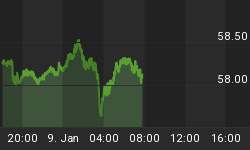One of the tools we have in our arsenal to identify the status of a Primary Degree trend is a simple analysis of the 14 month moving average versus a Slower moving average calculation, the 5 month MA of the 14 month. It has been terrific at identifying multi-year trends, both up and down. While it is a little late in generating the buy and sell signals, it triggered a "sell" near the start of Primary degree wave (4) down, in mid 2000. What followed was a two and a half year, 39 percent drop into the wave (4) bottom on October 10th, 2002. It took a while for this indicator to confirm that the rally which started on October 11th, 2002 would in fact be a multi-year primary degree wave (5) up. But by October 2003, this analytical tool did in fact trigger a Primary Degree "buy" signal. Since then, the primary degree rally has run 3 years further to new all-time nominal highs. We came close to a "sell" signal in mid- 2005, but the rally rejuvenated itself, continuing uninterrupted on its "buy." As of now, October 2006, it remains on its "buy," however the spread between the Fast and the Slow is substantially narrower than when this rally began, which means we must stay alert for a rapid unexpected cross-under, and new signal. The positive spread is now down to 140, as compared to being as high as 1,744 in December 2003. We require a 5 month moving average of the Spread between the Fast and Slow to reverse in a new direction for 3 consecutive months in order to declare that a new primary trend, a new multi-year trend, is underway. Knowledge of the primary trend is helpful in knowing where surprises are likely to occur in intermediate and short-term trends. Trading with the primary trend will prove more profitable.

There have only been two signals since 1997, so this tool is useful for long-term investors, as it filters out the noise of up and down corrections of significance in favor of the primary trend. It did give an early warning in 1999 and early 2000 as the two measures were nearly identical for several months. This chart is useful for our Conservative Balanced Investment Portfolio since once we get a new signal, we can rely upon that signal for several more years.
We look at the next chart as a confirming indicator for the Primary Trend Indicator shown earlier. What is nice about this indicator -- which is a comparison of the position of the 20 Month Moving average versus the 40 month -- is that once we get this indicator’s confirming "buy" or "sell," we can look forward with high confidence to a large chunk of the primary trend’s move remaining ahead of us.

For example, the 20 month MA crossed below the 40 month MA in February 2002, with the Dow Industrials at 10,106. From that "sell" signal point, the DJIA dropped an additional 2,909 points, or 28.8 percent. That suggests a great spot to purchase Leaps Put options.
Then, going the other way, the 20 month MA rose above the 40 month MA in August 2004, at DJIA 10,174. The Dow Industrials since rose 1,873 points, or 18.4 percent. Here, your strategy could be to either play long-term leaps call options, or to simply go long in the cash market and stay there, in other words, increase your long investment position.
There were no false crossovers or cross-unders with this confirming 20 Month/40 Month MA measure. Once it turned negative, the trend was down. Once it went positive, the trend was up.
We present these charts as part of our regular coverage, and call the indicator on the first chart our Primary Trend Indicator (PTI).
For a Free 30 day Trial Subscription, go to www.technicalindicatorindex.com and click on the button at the upper right of the Home Page. Check Out Our October Subscription Specials.
"Jesus said to her, "Did I not say to you if you believe,
you will see the glory of God?"
And so they removed the stone. And Jesus raised His eyes and said,
"Father, I thank Thee that Thou heardest Me.
And I knew that Thou hearest Me always, but because
of the people standing around I said it,
that they may believe that Thou didst send Me."
And when He had said these things, He cried out with a loud voice,
"Lazarus, come forth."
He who had died came forth, bound hand and foot with wrappings;
and his face was wrapped around with a cloth.
Jesus said to them, "Unbind him, and let him go."
John 11:40-44
If you are a trader, we offer market timing signals. If you are a conservative long-term investor, we have just come out with our Conservative Balanced Investment Portfolio, which we update for transactions on a regular basis.
















